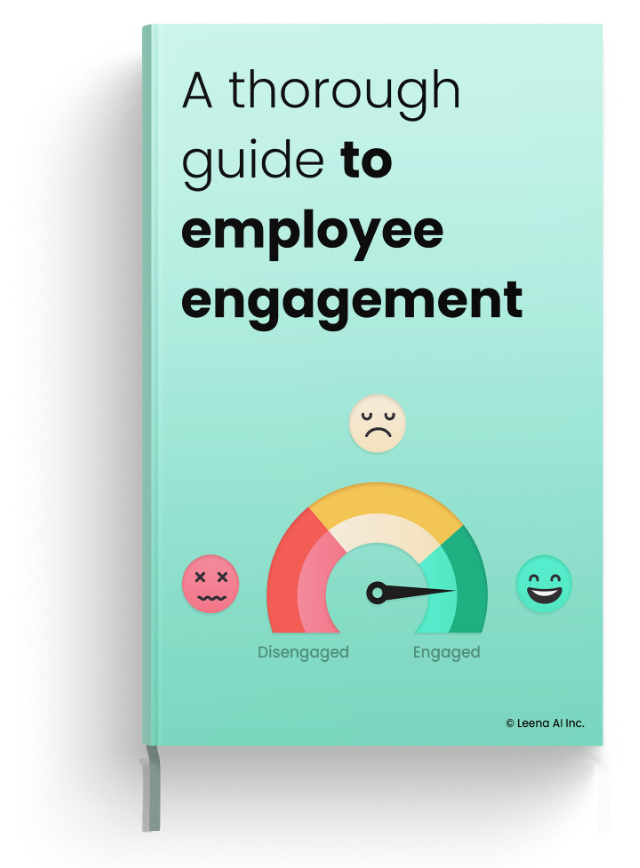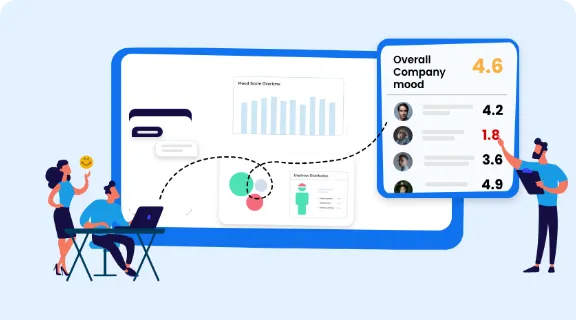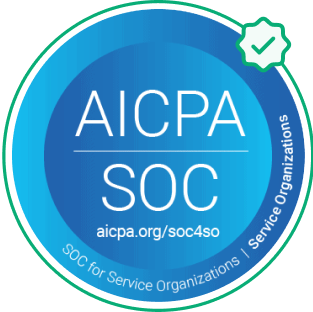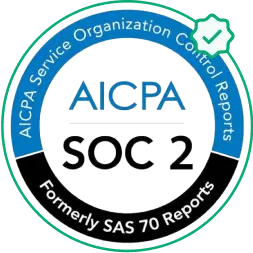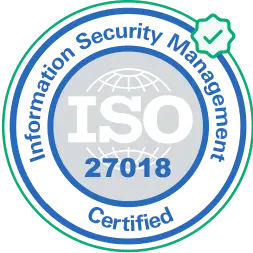Contents:
- What is employee engagement?
- What employee engagement is not?
- What are the different levels of employee engagement?
- What causes employee disengagement?
- How to spot disengagement among employees?
- How can you win back disengaged employees?
- How to build an engagement strategy that works for the millennials?
- What tools can help you improve employee engagement?
- What to keep in mind when buying employee engagement tools?
- How do you measure employee engagement?
- What perks do engaged employees bring to your organization?
What is employee engagement?
 Employee engagement is widely described as the level to which employees are committed to the organization and their job roles. It is a concept that is fundamental to understanding the relationship between an organization and its employees.From another perspective, employee engagement is an approach that helps ensure a working environment where every employee is motivated and cares about their job and the organization.
Employee engagement is widely described as the level to which employees are committed to the organization and their job roles. It is a concept that is fundamental to understanding the relationship between an organization and its employees.From another perspective, employee engagement is an approach that helps ensure a working environment where every employee is motivated and cares about their job and the organization.What employee engagement is not?
Employee engagement is not the same as employee satisfaction or employee happiness. An employee could be disengaged at work, yet be very happy due to reasons that have nothing to do with work.Employee engagement is not a one-time exercise. As this article from Forbes tells us, employee engagement isn't a workshop or a new wellness program and does not have an end date.What are the different levels of employee engagement?
 Engaged and committed: Also known as actively engaged or highly engaged employees, these are the people who are at the zenith of productivity and often help ensure a fun work environment. They are genuinely passionate about their work and can also motivate other lesser-engaged employees to show higher engagement levels when grouped with them on a project.Engaged: These are the employees that every company counts on to deliver work on time and keep productivity consistent. They might not be as committed and enthusiastic about work as the first category, but their dedication to their job role is utmost, their outlook is positive, and they are the backbone of almost every organization.Disengaged: Also known as the group which is “neither engaged nor committedâ€, these are the employees who simply clock their required hours, do the bare minimum, and are not particularly interested in achieving any goals. They are neither attached to their work nor the mission of the organization. They might be engaged for a while, but remain disengaged and detached for a majority of their workday.Actively disengaged: This is the group that has mentally checked out and is only around for the paycheck. They are often in disagreement with the organization's mission, do not hold the organization's leadership in high esteem, and simply do enough to ensure they're not fired. They are highly resistant to change and can also lead to an environment where other employees feel demotivated and detached.
Engaged and committed: Also known as actively engaged or highly engaged employees, these are the people who are at the zenith of productivity and often help ensure a fun work environment. They are genuinely passionate about their work and can also motivate other lesser-engaged employees to show higher engagement levels when grouped with them on a project.Engaged: These are the employees that every company counts on to deliver work on time and keep productivity consistent. They might not be as committed and enthusiastic about work as the first category, but their dedication to their job role is utmost, their outlook is positive, and they are the backbone of almost every organization.Disengaged: Also known as the group which is “neither engaged nor committedâ€, these are the employees who simply clock their required hours, do the bare minimum, and are not particularly interested in achieving any goals. They are neither attached to their work nor the mission of the organization. They might be engaged for a while, but remain disengaged and detached for a majority of their workday.Actively disengaged: This is the group that has mentally checked out and is only around for the paycheck. They are often in disagreement with the organization's mission, do not hold the organization's leadership in high esteem, and simply do enough to ensure they're not fired. They are highly resistant to change and can also lead to an environment where other employees feel demotivated and detached.What causes employee disengagement?
While employee engagement has risen to a record high of 34% as per a recent study, the same research also tells us that 53% of employees remain “not engagedâ€. Employee disengagement does not happen overnight but knowing what causes it can help you avoid expensive turnovers.
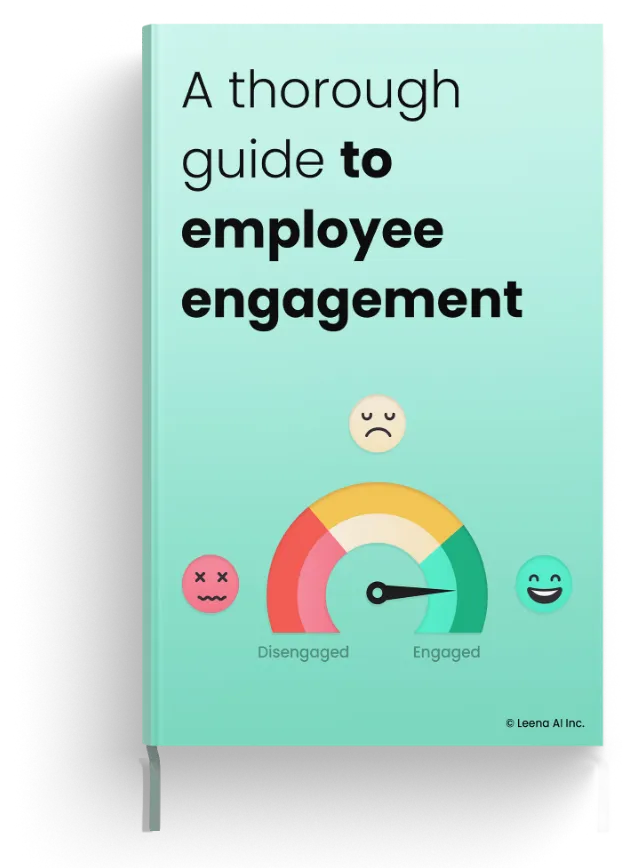
Like what you're reading but are short on time?We will deliver a PDF version to your mailbox.
How to spot disengagement among employees?
As mentioned earlier, disengagement does not occur overnight. While the actively disengaged and actively engaged employees might be easy to spot, the ones who are lingering between engagement and disengagement are the tricky ones.Disengagement is contagious, and you want to spot it before it hits the engaged employees. Here are a few warning signs that, if paid attention to, can help you fix the situation before attrition hits you and your organization irreparably. Refusing to be a team player: Regardless of whether an employee is your top performer or not, constant refusal to be a part of team conversations and activity might be a sign of engagement. You might have an introvert on your hands and they'd take time to open up, but that one employee who is always missing when it comes to team activities and refuses to share the team's excitement is the one you need to pay special attention to.Lack of initiative in terms of work: It is widely known that poor performance is a sign of disengagement, but it might also be the top performers you need to observe closely. A disengaged employee might be a top performer simply because they've now gotten used to the work they do and practiced it enough to excel at it. However, when your top performer refuses to take up different kinds of tasks or backs out of a spontaneous challenge, that's a red flag you'll need to watch out for.Deafening silence: Silence isn't always a bad thing, but when an employee entirely refuses to engage in any conversation- be it via email or even one-on-one calls/chats- it's a massive red herring. It's essential to distinguish between introversion and distancing, and when an employee shows signs of being distant, it is essential to reach out to them and have an open, honest conversation about what's wrong.Unusual absenteeism levels: This is not to say that an employee cannot have health issues, physical or mental, which need them to take leaves from work more often than others. However, it is essential to pay attention to long periods of unexplained absence from work. Engagement among employees often encourages them to find reasons to make it to work. When absenteeism becomes a part of any employee's typical behaviour, it is time for a caring dialogue.Drop in work quality: Every employee's interest level will vary from project to project. It's easy to see how certain projects will light up your employee's eyes while another will receive a slightly more lukewarm response. It becomes an alarm bell when a certain employee/s shows constant disinterest in work, repeatedly misses deadlines for no apparent reason, and does not come up with new ideas.
Refusing to be a team player: Regardless of whether an employee is your top performer or not, constant refusal to be a part of team conversations and activity might be a sign of engagement. You might have an introvert on your hands and they'd take time to open up, but that one employee who is always missing when it comes to team activities and refuses to share the team's excitement is the one you need to pay special attention to.Lack of initiative in terms of work: It is widely known that poor performance is a sign of disengagement, but it might also be the top performers you need to observe closely. A disengaged employee might be a top performer simply because they've now gotten used to the work they do and practiced it enough to excel at it. However, when your top performer refuses to take up different kinds of tasks or backs out of a spontaneous challenge, that's a red flag you'll need to watch out for.Deafening silence: Silence isn't always a bad thing, but when an employee entirely refuses to engage in any conversation- be it via email or even one-on-one calls/chats- it's a massive red herring. It's essential to distinguish between introversion and distancing, and when an employee shows signs of being distant, it is essential to reach out to them and have an open, honest conversation about what's wrong.Unusual absenteeism levels: This is not to say that an employee cannot have health issues, physical or mental, which need them to take leaves from work more often than others. However, it is essential to pay attention to long periods of unexplained absence from work. Engagement among employees often encourages them to find reasons to make it to work. When absenteeism becomes a part of any employee's typical behaviour, it is time for a caring dialogue.Drop in work quality: Every employee's interest level will vary from project to project. It's easy to see how certain projects will light up your employee's eyes while another will receive a slightly more lukewarm response. It becomes an alarm bell when a certain employee/s shows constant disinterest in work, repeatedly misses deadlines for no apparent reason, and does not come up with new ideas.How can you win back disengaged employees?

How to build an engagement strategy that works for the millennials?
When building an engagement strategy that works for workplaces at present, millennials need to be at the centre of it. Reason: by 2025, 75% of the workforce is expected to be millennials. Before we go further, let's familiarize ourselves with this group of employees. Millennials are the employees who are between the ages of 24 and 39 at the moment, are relatively well versed with technology, and look for purpose in their jobs a lot more than previous generations did. As you must have already figured out, this generation of employees won't make do with a job that simply pays them well and keeps their boat floating.While millennials are not a homogenous group and these pointers won't apply to every member of this group, here are a few things you can keep in mind to build a strategy that keeps the millennials engaged.Make them aware of your mission and vision: Millennials are known to be a generation that believes in cutting to the chase. Making these employees aware of what your organization aims to achieve can help them feel more attached to their job and the organization. Also, be open to feedback on your company's mission and vision because millennials are more likely to speak their mind than the older generations in your organization.Uphold positive company culture: This is a generation that wants to see their job serving a purpose and a bigger goal. They cannot do any of that if the company culture is toxic or stagnant. Taking initiatives to ensure your company culture is positive, conducive to growth, and driven by equity, might have a key role in keeping millennials engaged.Hold them accountable: Surprisingly enough, millennials seem to have an affinity for accountability. Commonly perceived as a highly irresponsible generation, 56% of millennials feel more engaged at work when their managers hold them accountable. These employees care deeply about seeing their projects reach the finish line and innately feel a sense of ownership towards any project they take up.Provide them opportunities to volunteer: This is a group driven by their need to change the world and give back to society. Allowing them to volunteer at places your organization is tied with would serve two purposes: give them an insight into what you are doing to give back to society and satisfy their need to help the needy. Setting up volunteer days or letting them forego their lunch for the sake of someone who needs it more are little ways to help them feel more engaged.Give them a fair degree of autonomy: This is not to say that millennials want to work in an office that believes in complete lack of rules and prefers anarchy. However, this generation does want to have a certain degree of autonomy over their work timings and job roles. Giving them the right to work remotely a few days a week or letting them choose their shift timings could help them engage considerably more with your organization.
Before we go further, let's familiarize ourselves with this group of employees. Millennials are the employees who are between the ages of 24 and 39 at the moment, are relatively well versed with technology, and look for purpose in their jobs a lot more than previous generations did. As you must have already figured out, this generation of employees won't make do with a job that simply pays them well and keeps their boat floating.While millennials are not a homogenous group and these pointers won't apply to every member of this group, here are a few things you can keep in mind to build a strategy that keeps the millennials engaged.Make them aware of your mission and vision: Millennials are known to be a generation that believes in cutting to the chase. Making these employees aware of what your organization aims to achieve can help them feel more attached to their job and the organization. Also, be open to feedback on your company's mission and vision because millennials are more likely to speak their mind than the older generations in your organization.Uphold positive company culture: This is a generation that wants to see their job serving a purpose and a bigger goal. They cannot do any of that if the company culture is toxic or stagnant. Taking initiatives to ensure your company culture is positive, conducive to growth, and driven by equity, might have a key role in keeping millennials engaged.Hold them accountable: Surprisingly enough, millennials seem to have an affinity for accountability. Commonly perceived as a highly irresponsible generation, 56% of millennials feel more engaged at work when their managers hold them accountable. These employees care deeply about seeing their projects reach the finish line and innately feel a sense of ownership towards any project they take up.Provide them opportunities to volunteer: This is a group driven by their need to change the world and give back to society. Allowing them to volunteer at places your organization is tied with would serve two purposes: give them an insight into what you are doing to give back to society and satisfy their need to help the needy. Setting up volunteer days or letting them forego their lunch for the sake of someone who needs it more are little ways to help them feel more engaged.Give them a fair degree of autonomy: This is not to say that millennials want to work in an office that believes in complete lack of rules and prefers anarchy. However, this generation does want to have a certain degree of autonomy over their work timings and job roles. Giving them the right to work remotely a few days a week or letting them choose their shift timings could help them engage considerably more with your organization.
Like what you're reading but are short on time?
What tools can help you improve employee engagement?
Employee engagement might look like an entirely manual process, but it does not have to be. Even though engagement does need a fair amount of intervention from the HR, several tools in the market can help you in your quest for employee engagement.
Collaboration tools:
Given the shift to a remote workplace, collaboration has become exceptionally tricky to navigate. Communication and collaboration play an important role in maintaining company culture, ensuring transparency, and making employees feel like they are part of the organization. Take your pick from this exhaustive list and invest in a collaboration tool so that your employees can engage in as much water cooler banter as they want to. These tools can also make it easier for you to immediately reach out to an employee who shows signs of disengagement.Training tools: As mentioned earlier, the present workforce holds the need for professional development and growth in high regard. Investing in a tool that helps you deliver and manage training content and allows employees to track their development can help employees feel their learning goals matter to you. You can also customize learning content to fit the particular needs of your employees. Here's a list that can help you choose software that aligns best with your organisation's needs.Employee recognition tools: Given the role recognition plays in keeping employees engaged, a tool that can help you digitize employee recognition programs should be the top priority. Such software makes it easy for you to send out praise for a whole team or department or an individual and give out gift cards as rewards for employee performance. Recognition initiative of the sort also helps encourage other employees to perform better. Invest in the one you like from this list.Employee engagement tools: If you're looking for software that will help you manage most of your engagement needs, then go for a holistic employee engagement software. From giving you insights into your employees' engagement level to helping you build and send out pulse surveys that ensure you regularly receive feedback from your employees, such a tool can take off a significant part of the load from your shoulders. Here's a list to make your search easier.What to keep in mind when buying employee engagement tools?
Employee engagement software uses a combination of pulse surveys and data analytics to provide insights into employee engagement within an organization. It analyzes employee feedback and provides actionable insight to HR managers which they can use to identify areas of employee disengagement that need to be worked on.Now, how do you assess whether or not you need employee engagement software and how do you choose the best one? Here are a few tips to make your buying process easier, but for a more detailed walkthrough of the same, you can read our detailed buyer's guide.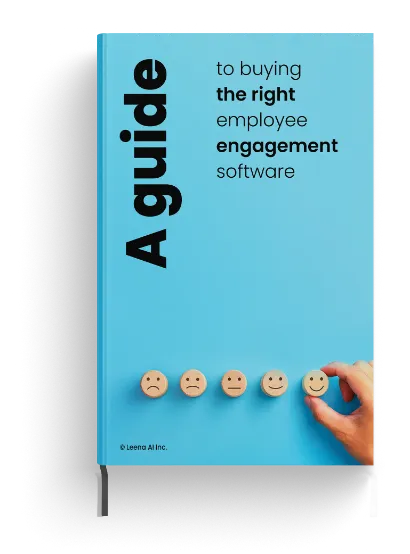
For a more detailed walkthrough
of the same, you can read our
detailed buyer's guide.
of the same, you can read our
detailed buyer's guide.
Read now
How do you measure employee engagement?
 Engagement and attachment are essentially emotions, making it difficult to measure them and quantify them into specific numbers. This applies to employee engagement as well. You can pay attention to specific metrics that can help you gauge the level of engagement within your organization. Unless you're getting your engagement measured by a survey provider, here are the metrics you need to keep a watch on.Employee absenteeism: Do your employees seem happy while they're at work but ask for time off a lot more often than is normal? This might be a sign of disengagement. Employees who are genuinely engaged will make an effort to turn up to work. If you're noticing high absenteeism levels, it's an indicator of a lower engagement level within your organization.Turnover rate: While turnover rates can differ from industry to industry, most market research seems to agree that 10% is a healthy turnover rate that every organization should look to maintain. If your employee turnover is a lot higher than this accepted average, that might reflect engagement levels within your organization. People leave jobs for different reasons. So once you've got your employee turnover rate calculated, looking into why it's higher than usual might help resolve a major part of the problem.Employee Net Promoter Score (eNPS): This score is based on a simple analysis. Your employees might be delighted here, but would they recommend this organization to another person? The answer to this question can help reveal your employees' exact level of loyalty towards their workplace. This score was initially used to gauge customer satisfaction, but adopting such a calculation method internally can help you figure out engagement levels without much effort.Feedback surveys: Though this might seem like the most done and dusted method to measure employee engagement, it is also one of the most tried and tested ones. Taking a closer look into the responses employees give to feedback surveys and taking stock of how many bother even to respond, can give you a fair idea of the level of attachment employees feel towards the organization.Exit interviews: Once an employee is about to exit the organization, they usually hold nothing back. No survey will give you as much honest insight into things as an exit interview. This is the final nail in the coffin and employees often hammer it in pretty ruthlessly. Pay attention to exit interviews of employees and you might figure out what to fix to ensure higher engagement and lower attrition.
Engagement and attachment are essentially emotions, making it difficult to measure them and quantify them into specific numbers. This applies to employee engagement as well. You can pay attention to specific metrics that can help you gauge the level of engagement within your organization. Unless you're getting your engagement measured by a survey provider, here are the metrics you need to keep a watch on.Employee absenteeism: Do your employees seem happy while they're at work but ask for time off a lot more often than is normal? This might be a sign of disengagement. Employees who are genuinely engaged will make an effort to turn up to work. If you're noticing high absenteeism levels, it's an indicator of a lower engagement level within your organization.Turnover rate: While turnover rates can differ from industry to industry, most market research seems to agree that 10% is a healthy turnover rate that every organization should look to maintain. If your employee turnover is a lot higher than this accepted average, that might reflect engagement levels within your organization. People leave jobs for different reasons. So once you've got your employee turnover rate calculated, looking into why it's higher than usual might help resolve a major part of the problem.Employee Net Promoter Score (eNPS): This score is based on a simple analysis. Your employees might be delighted here, but would they recommend this organization to another person? The answer to this question can help reveal your employees' exact level of loyalty towards their workplace. This score was initially used to gauge customer satisfaction, but adopting such a calculation method internally can help you figure out engagement levels without much effort.Feedback surveys: Though this might seem like the most done and dusted method to measure employee engagement, it is also one of the most tried and tested ones. Taking a closer look into the responses employees give to feedback surveys and taking stock of how many bother even to respond, can give you a fair idea of the level of attachment employees feel towards the organization.Exit interviews: Once an employee is about to exit the organization, they usually hold nothing back. No survey will give you as much honest insight into things as an exit interview. This is the final nail in the coffin and employees often hammer it in pretty ruthlessly. Pay attention to exit interviews of employees and you might figure out what to fix to ensure higher engagement and lower attrition.
Like what you're reading but are short on time?We will deliver a PDF version to your mailbox.
What perks do engaged employees bring to your organization?
Engaged employees are happy and high on productivity. Just like disengagement, engagement too is contagious. Employees who are actively engaged can light up the whole department and ensure everyone remains productive.
You may also like
Discover what matters to
your employees in theirown words

